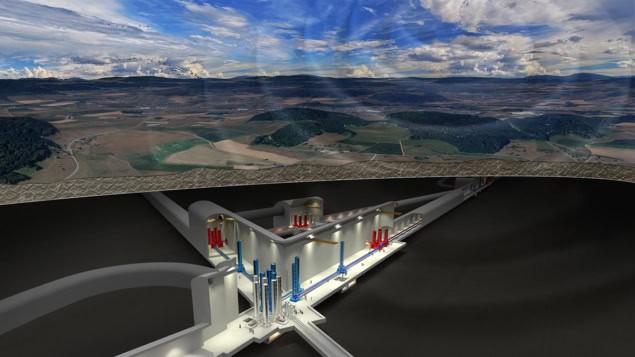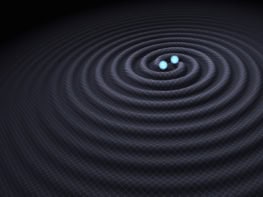Ten years after the first gravitational waves were detected, members of the €2bn Einstein Telescope collaboration are narrowing down the location and design for what would be a third-generation gravitational-wave detector. Senne Starckx reports on progress

A decade ago, on 14 September 2015, the twin detectors of the Laser Interferometer Gravitational-Wave Observatory (LIGO) in Hanford, Washington, and Livingston, Louisiana, finally detected a gravitational wave. The LIGO detectors – two L-shaped laser interferometers with 4 km-long arms – had measured tiny differences in laser beams bouncing off mirrors at the end of each arm. The variations in the length of the arms, caused by the presence of a gravitational wave, were converted into the now famous audible “chirp signal”, which indicated the final approach between two merging black holes.
Since that historic detection, which led to the 2017 Nobel Prize for Physics, the LIGO detectors, together with VIRGO in Italy, have measured several hundred gravitational waves – from mergers of black holes to neutron-star collisions. More recently, they have been joined by the KAGRA detector in Japan, which is located some 200 m underground, shielding it from vibrations and environmental noise.
Yet the current number of gravitational waves could be dwarfed by what the planned Einstein Telescope (ET) would measure. This European-led, third-generation gravitational-wave detector would be built several hundred metres underground and be at least 10 times more sensitive than its second-generation counterparts including KAGRA. Capable of “listening” to a thousand times larger volume of the universe, the new detector would be able to spot many more sources of gravitational waves. In fact, the ET will be able to gather in a day what it took LIGO and VIRGO a decade to collect.
The ET is designed to operate in two frequency domains. The low-frequency regime – 2–40 Hz – is below current detectors’ capabilities and will let the ET pick up waves from more massive black holes. The high-frequency domain, on the other hand, would operate from 40 Hz to 10 kHz and detect a wide variety of astrophysical sources, including merging black holes and other high-energy events. The detected signals from waves would also be much longer with the ET, lasting for hours. This would allow physicists to “tune in” much earlier as black holes or neutron stars approach each other.
Location, location, location
But all that is still a pipe dream, because the ET, which has a price tag of €2bn, is not yet fully funded and is unlikely to be ready until 2035 at the earliest. The precise costs will depend on the final location of the experiment, which is still up for grabs.
Three regions are vying to host the facility: the Italian island of Sardinia, the Belgian-German-Dutch border region and the German state of Saxony. Each candidate is currently investigating the suitability of its preferred site (see box below), the results of which will be published in a “bid book” by the end of 2026. The winning site will be picked in 2027 with construction beginning shortly after.
Other factors that will dictate where the ET is built include logistics in the host region, the presence of companies and research institutes (to build and exploit the facility) and government support. With the ET offering high-quality jobs, economic return, scientific appeal and prestige, that could give the German-Belgian-Dutch candidacy the edge given the three nations could share the cost.
Another major factor is the design of the ET. One proposal is to build it as an equilateral triangle with each side being 10 km. The other is a twin L-shaped design where both arms are 15 km long and each detector located far from each other. The latter design is similar to the two LIGO over-ground detectors, which are 3000 km apart. If the “2L design” is chosen, the detector would then be built at two of the three competing sites.
The 2L design is being investigated by all three sites, but those behind the Sardinia proposal strongly favour this approach. “With the detectors properly oriented relative to each other, this design could outperform the triangular design across all key scientific objectives,” claims Domenico D’Urso, scientific director of the Italian candidacy. He points to a study by the ET collaboration in 2023 that investigated the impact of the ET design on its scientific goals. “The 2L design enables, for example, more precise localization of gravitational wave sources, enhancing sky-position reconstruction,” he says. “And it provides superior overall sensitivity.”
Where could the next-generation Einstein Telescope be built?
Three sites are vying to host the Einstein Telescope (ET), with each offering various geological advantages. Lausitz in Saxony benefits from being a former coal-mining area. “Because of this mining past, the subsurface was mapped in great detail decades ago,” says Günther Hasinger, founding director of the German Center for Astrophysics, which is currently being built in Lausitz and would house the ET if picked. The granite formation in Lausitz is also suitable for a tunnel complex because the rock is relatively dry. Not much water would need to be pumped away, causing less vibration.
Thanks to the former lead, zinc and silver mine of Sos Enattos, meanwhile, the subsurface near Nuoro in Sardinia – another potential location for the ET – is also well known. The island is on a very stable, tectonic microplate, making it seismically quiet. Above ground, the area is undeveloped and sparsely populated, further shielding the experiment from noise.
The third ET candidate, lying near the point where Belgium, Germany and the Netherlands meet, also has a hard subsurface, which is needed for the tunnels. It is topped by a softer, clay-like layer that would dampen vibrations from traffic and industry. “We are busy investigating the suitability of the subsurface and the damping capacity of the top layer,” says Wim Walk of the Dutch Center for Subatomic Physics (Nikhef), which is co-ordinating the candidacy for this location. “That research requires a lot of work, because the subsurface here has not yet been properly mapped.”
Localization is important for multimessenger astronomy. In other words, if a gravitational-wave source can be located quickly and precisely in the sky, other telescopes can be pointed towards it to observe any eventual light or other electromagnetic (EM) signals. This is what happened after LIGO detected a gravitational wave on 17 August 2017, originating from a neutron star collision. Dozens of ground- and space-based satellites were able to pick up a gamma-ray burst and the subsequent EM afterglow.
The triangle design, however, is favoured by the Belgian-German-Dutch consortium. It would be the Earth equivalent to the European Space Agency’s planned LISA space-based gravitational-waves detector, which will consist of three spacecraft in a triangle configuration that is set for launch in 2035, the same year that the ET could open. LISA would detect gravitational waves with even much lower frequency, coming, for example, from mergers of supermassive black holes. Rainer Weiss: 50 years of LIGO and gravitational waves
While the Earth-based triangle design would not be able to locate the source as precisely, it would – unlike the 2L design – be able to do “null stream” measurements. These would yield a clearer picture of the noise from the environment and the detector itself, including “glitches”, which are bursts of noise that overlap with gravitational-wave signals. “With a non-stop influx of gravitational waves but also of noise and glitches, we need some form of automatic clean-up of the data,” says Jan Harms, a physicist at the Gran Sasso Science Institute in Italy and member of the scientific ET collaboration. “The null stream could provide that.”
However, it is not clear if that null stream would be a fundamental advantage for data analysis, with Harms and colleagues thinking more work is needed. “For example, different forms of noise could be connected to each other, which would compromise the null stream,” he says. The problem is also that a detector with a null stream has not yet been realized. And that applies to the triangle design in general. “While the 2L design is well established in the scientific community,” adds D’Urso.
Backers of the triangle design see the ET as being part of a wider, global network of third-generation detectors, where the localization argument no longer matters. Indeed, the US already has plans for an above-ground successor to LIGO. Known as the Cosmic Explorer, it would feature two L-shaped detectors with arm lengths of up to 40 km. But with US politics in turmoil, it is questionable how realistic these plans are.
Matthew Evans, a physicist at the Massachusetts Institute of Technology and member of the LIGO collaboration, recognizes the “network argument”. “I think that the global gravitational waves community are double counting in some sense,” he says. Yet for Evans it is all about the exciting discoveries that could be made with a next-generation gravitational-wave detector. “The best science will be done with ET as 2Ls,” he says.



